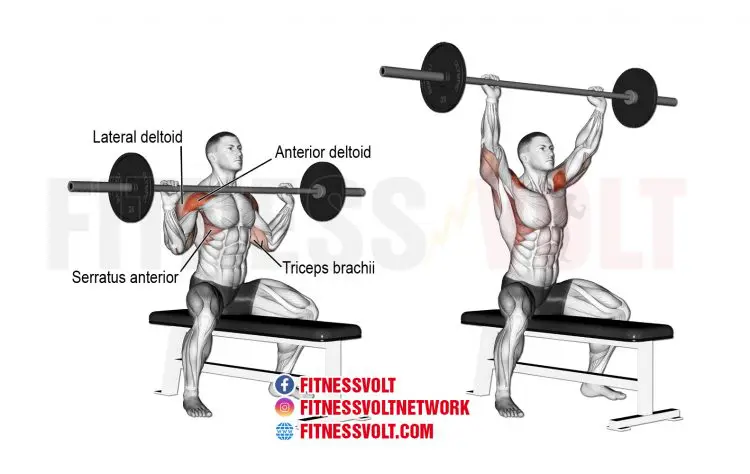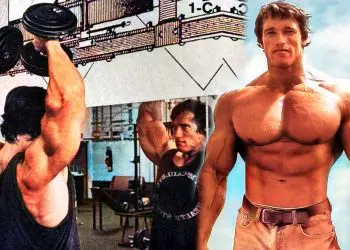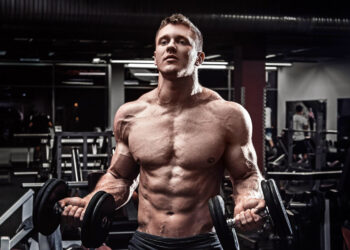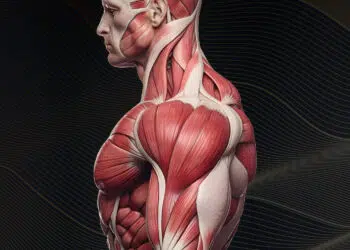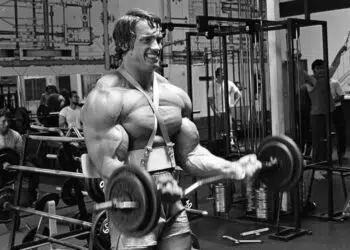The military or overhead press is a classic strength training exercise. In fact, as recently as the 1960s, it used to be one of the Olympic lifts. It’s no longer contested in Olympic lifting competitions, but it’s still a regular event in most strongman meets.
As well as being a test of strength, the military press is one of the best ways to develop a powerful upper body. It targets your deltoids and works your upper traps and triceps too.
While you can do military presses standing, it could be even more effective when you do it seated, especially if your primary goal is building bigger shoulders.
In this article, we explain why and how to do seated military presses and reveal eight of the best variations and alternatives.
Seated Military Press – Muscles Worked
The seated military press is a compound exercise. That means it involves two or more joints and several muscles working together. The main muscles developed by seated military presses are:
Level Up Your Fitness: Join our 💪 strong community in Fitness Volt Newsletter. Get daily inspiration, expert-backed workouts, nutrition tips, the latest in strength sports, and the support you need to reach your goals. Subscribe for free!
Deltoids – the deltoids are your shoulder muscles. There are three sets of fibers, called heads, that make up the deltoids:
- Anterior (front)
- Medial (middle)
- Posterior (rear)
All three deltoid heads are involved in seated military presses. Still, the anterior is the most active, and the rear deltoid is the least active, with the medial deltoid somewhere in between.
Triceps brachii – located on the back of your upper arm, the triceps are responsible for extending your elbow joint. The triceps are the largest upper arm muscle, and seated overhead presses deliver an effective triceps workout.
Trapezius – this large kite-shaped muscle covers much of your upper back. Like the deltoids, the trapezius is made up of three sets of fibers:
- Upper
- Middle
- Lower
All three sets of trap fibers are involved in seated military presses, but the upper and middle are the most active.
Rhomboids – located between your shoulder blades, the rhomboids help keep your scapulae back and together during seated overhead presses. Working with your middle trapezius, the rhomboids are critical for good posture.
Rotator cuff – this is the collective term for the muscles beneath your deltoids. While they don’t contribute much if anything to shoulder size, they’re very important for function and joint health. The rotator cuff muscles are the supraspinatus, infraspinatus, teres minor, and subscapularis.
Serratus anterior – located just below your armpits and above your ribs, the serratus anterior is so-called because, when well-developed, it looks like the edge of a serrated blade. This small muscle helps keep your scapulae flat against your ribs and prevents your shoulder blades from winging (sticking outward).
How to Do Seated Military Presses
Get more from seated military presses while keeping your risk of injury to a minimum by following these guidelines:
- Using a power rack or dedicated seated military press bench, set your barbell to shoulder height. The bench should be roughly vertical. You can also do this exercise without back support.
- Alternatively, you can clean the bar to your shoulders and then sit down if you don’t have access to a power rack or seated press bench.
- Sit on the bench and grip the bar so your hands are slightly wider than shoulder-width apart, palms facing forward.
- Plant your feet firmly on the floor, brace your core, and pull your shoulders down and back. Unrack the bar and hold it in front of your upper chest/clavicles.
- Extend your arms and press the bar straight up and overhead, taking care not to hit your chin.
- Lower the bar back to your upper chest and repeat.
Note: Some people like to do seated military presses behind the neck. While this does change how the deltoids are recruited, it also puts more stress on the shoulder joints and could even lead to shoulder pain and injury. Only do behind-the-neck seated military presses if you have healthy shoulders and excellent upper-body mobility. Even then, the risks may outweigh the benefits.
Seated Military Press Benefits and Drawbacks
Not sure if seated military presses are the right shoulder exercise for you? Consider these benefits and then decide!
No assistance from your legs – while military presses are often done standing, that variation means you could use your legs to help you drive the weight up. Seated military presses prevent you from using your legs, making it a much stricter exercise and all but cheat-proof.
Plenty of back support – the seated military press is usually done on a bench with an upright backrest. This provides lots of support for your lower back, taking stress off what is an area of weakness for some lifters. If standing military presses cause back pain, you’ll probably welcome this additional level of support.
An effective mass builder – seated military presses are a popular bodybuilding exercise. Including this exercise in your upper body workouts should result in bigger, more powerful deltoids.
While seated military presses are a mostly beneficial exercise, there are also a few drawbacks to consider:
An awkward movement – the seated military press can be a little uncomfortable for some people. The bar needs to travel straight up, which means it could hit you under the chin. As such, you’ll need to learn to keep your chin tucked in or move the bar around your head. Making the switch to dumbbells negates this problem.
Standing military presses mean lifting more weight – most people can lift more weight if they do military presses standing. This means the seated military press may not be as good for building strength as the standing variation.
You need a power rack or military press bench to do them – while you can clean the bar to your shoulders and then sit down, this exercise is much safer and more convenient done in a power rack or using a military press bench. As such, some people may not have the equipment needed to do this pressing exercise.
Level Up Your Fitness: Join our 💪 strong community in Fitness Volt Newsletter. Get daily inspiration, expert-backed workouts, nutrition tips, the latest in strength sports, and the support you need to reach your goals. Subscribe for free!
8 Seated Military Press Variations and Alternatives
Seated military presses are a highly effective deltoid exercise, but that doesn’t mean you need to do it all the time. There are several variations and alternatives you can use to keep your workouts productive and interesting:
1. Seated dumbbell military press
Seated dumbbell military presses are every bit as effective as the barbell version, but some lifters find them more comfortable. The weights are free to travel either side of your head, making for a more natural pressing movement. Also, controlling two weights instead of one may increase deltoid engagement.
On the downside, getting two heavy dumbbells into position is not always easy, especially compared to using a power rack or military press bench.
Learn how to do seated dumbbell presses here.
2. Dead-stop military press
This exercise, which is done in a power rack, involves a purposeful pause between reps, and each rep starts with the bar resting on the pins. This means you’ll need to work harder to move the weight and explode the bar upward to blast past any sticking points. The pause helps eliminate the stretch reflex, which means every rep is more demanding. This exercise is useful for building strength, size, and muscle power.
How to do it:
- Sit on an upright bench in a power rack with your barbell resting on the safety bars set to shoulder height.
- Hold the bar with an overhand, slightly wider than shoulder-width grip. Pull your shoulders down and back, brace your core, and plant your feet firmly on the floor.
- Press the bar up and off the pins to arms’ length.
- Lower the bar back down to the pins, let it settle for 1-2 seconds and then repeat.
- You can also do this exercise on a flat bench and without back support.
3. Z press
The Z press is a barbell overhead pressing exercise named after legendary Lithuanian strongman Žydrūnas Savickas, better known as Big Z. While Big Z was and still is a tremendous all-around strongman, he is especially known for his prodigious strength in the overhead lifts, having held several world records in the log press, axel press, and metal block press.
In simple terms, the Z press involves pressing a barbell overhead while sitting on the floor with your legs extended in front of you. This eliminates your legs from the movement, so you have to rely entirely on your upper body to complete each rep. Z presses also force you to use your core to keep your torso upright.
Learn how to do Z presses here.
4. Bradford press
The Bradford press is named after American weightlifter Jim Bradford, famed for his huge shoulders and overhead pressing strength. Because this exercise involves a behind-the-neck component, perform it with caution or avoid it entirely if you have a history of shoulder pain.
This exercise can be done seated or standing. It works best with light to moderate weights and medium to high reps. Chase the pump!
How to do it:
- Set up as usual for seated military presses.
- With your abs braced, press the bar up.
- As it approaches the top of your head, lift the bar over and then behind your head to the back of your neck. Do not raise the bar higher; it should just skim the top of your head.
- Press the bar from your neck back over your head and then lower it to your upper chest.
- That’s one rep; keep going!
5. Arnold press
Named after bodybuilding legend Arnold Schwarzenegger, this exercise combines a sort-of seated pec fly with an overhead press to really hammer your anterior deltoids.
Compared with regular dumbbell overhead presses, you probably won’t be able to use such heavy weights when doing the Arnold press. Still, the demanding movement will ensure that you still get a great workout from this exercise.
Some bodybuilders find the Arnold press a little shoulder un-friendly, so progress with care. Arnold presses can be done seated or standing and using dumbbells or kettlebells.
Learn how to overhead press like Arnold here.
6. Resistance band military press
No weights? No problem! You can get a great shoulder workout using nothing but a resistance band and a standard kitchen chair. This exercise is perfect for home workouts. It’s also more joint-friendly than the barbell and dumbbell variations.
How to do it:
- Sit on a chair or bench and loop your resistance band underneath it. Take an end in each hand and raise them to shoulder height, hands facing forward. Brace your core and pull your shoulders down and back.
- Press the handles up and overhead, and then return to the starting position.
- Continue for the desired number of repetitions.
7. Pike push-up
Pike push-ups are a convenient way to work your deltoids and triceps without equipment. As such, this is an excellent exercise for anyone who works out at home or simply prefers bodyweight training.
How to do it:
- Adopt the push-up position with your arms straight, core tight, and hands slightly wider than shoulder-width apart.
- Push your hips back and up, and walk your hands toward your feet, so your body forms an inverted V or pile position.
- Bend your arms and lower your head down to the floor.
- Push back up and repeat.
- You can make this exercise harder by elevating your feet.
8. Smith machine military press
A lot of exercisers and strength training coaches dislike the Smith machine. They say things like it’s not functional or that it makes exercises easier compared to the freeweights version. But, in reality, the Smith machine is just another workout tool, and it’s neither better nor worse than freeweights – it’s just different!
As such, you can use the Smith machine for seated military presses. Yes, the weight is guided and balanced, but that may be an advantage if you are training alone, want to work to failure, or are training specifically for hypertrophy.
Learn how to do Smith machine military presses here.
Seated Military Press – Wrapping Up
The seated military press is a classic bodybuilding exercise. So, if you want to build bigger, stronger delts and triceps, this move will definitely help. That’s why it’s such a popular exercise – it REALLY works!
But, as effective as the seated military overhead press undoubtedly is, it’s not for everyone. Some lifters report that this exercise causes shoulder pain. Or, you may not have access to the equipment necessary to do it correctly.
No worries! There are several equally effective exercises you can do instead.
Regardless, if you want shoulders you can be proud of, you NEED to start pushing some heavy iron overhead!
Interested in measuring your progress? Check out our strength standards for Push Ups, Arnold Press, Clean, and more.

